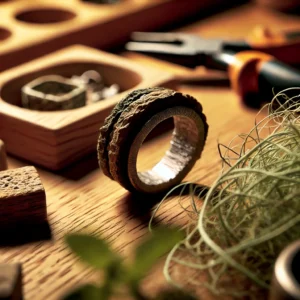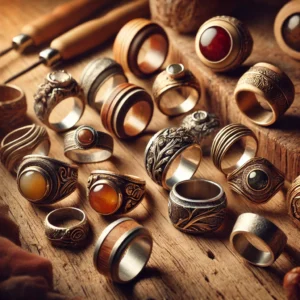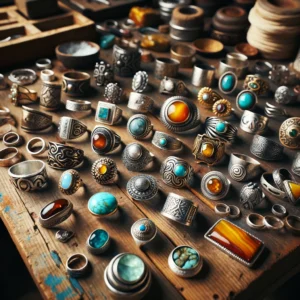Handmade Rings:
Tradition, Innovation, and Trends
Handmade rings, more than mere pieces of jewelry, are true works of art that capture the essence of creativity and tradition. In a world dominated by fast fashion and mass production, artisanal jewelry stands out for its authenticity and connection to cultural and artistic roots. This type of jewelry is not just a style choice; it’s a statement of values, a tribute to human skill, and a conscious move toward more sustainable practices.
The Charm of Handmade Rings
“Handcrafted rings that blend art and passion for jewelry, bringing unique creations to life.”
Handmade rings are especially cherished for their personalization and exclusivity. Each ring is unique, with subtle variations reflecting the artisan’s touch. This uniqueness is part of their appeal: when someone buys a handcrafted ring, they acquire a one-of-a-kind piece that won’t be duplicated on another hand. The materials used, from precious metals to semi-precious stones and organic elements, are carefully selected, often with a focus on sustainability and ethics.
Traditional and Modern Techniques
Artisan jewelry combines traditional techniques passed down through generations with contemporary innovations to create pieces that are both classic and modern. Techniques like forging, chiseling, embossing, and lost-wax casting are common. These methods allow jewelers to express a wide range of styles, from the charming rusticity of textured silver rings to the elegant sophistication of polished gold rings with gemstone inlays.
Current Trends in Rings
Trends in handmade rings reflect a growing desire for individuality and personal expression. Today’s consumers seek pieces that tell a story or represent something meaningful about their lives and values. Popular trends include:
- Rings with Personalized Messages: Engravings featuring dates, names, or messages that hold special meaning for the wearer.
- Nature-Inspired Designs: Motifs mimicking organic forms like leaves, flowers, and bark textures, reflecting a return to natural elements.
- Use of Unconventional Materials: Incorporating materials such as wood, resin, or even meteorite fragments, offering a distinctive and often sustainable aesthetic.
- Multi-Functional Rings: Designs that can be worn in different ways or on various fingers, catering to the versatility many seek in their accessories.
Artisan jewelry, particularly handmade rings, is more popular than ever—not only because of its beauty but because it represents a legacy of craftsmanship, a deeper connection to the culture of manual artistry, and a commitment to responsible consumption practices. In a world increasingly valuing personalized and meaningful items, handmade rings offer the perfect way to express individuality while supporting artisans and their traditional techniques. This blend of history, art, and fashion ensures that artisan jewelry remains a strong and relevant trend in the fashion world.
Sustainability and Craftsmanship: Sustainable Materials and Techniques in Handcrafted Jewelry

Artisan jewelry is not only a tribute to tradition and human talent but also an opportunity to embrace more sustainable and environmentally friendly practices. Handmade silver rings, in particular, exemplify how sustainable materials and artisanal techniques can come together to create beautiful, responsible pieces.
Sustainable Materials in Jewelry
Sustainability in jewelry begins with the choice of materials. Recycled metals, such as silver and gold, are increasingly popular among artisan jewelers mindful of the environmental impact of mining. Using recycled silver not only reduces the demand for new resource extraction but also provides quality comparable to new silver without the associated environmental costs. Additionally, many artisans choose to incorporate ethically sourced gemstones or alternative materials like certified wood, recycled crystals, and even plastics recovered from the ocean, all in an effort to minimize the ecological footprint of their creations.
Artisanal Jewelry Techniques
Artisan jewelry is characterized by techniques that require significant skill and meticulous attention to detail. Some of these techniques include:
- Hand Forging: This traditional method involves shaping the metal using hammers and anvils, allowing the artisan to have a direct and physical connection with the material, resulting in unique and unrepeatable pieces.
- Lost-Wax Casting: A centuries-old technique that offers immense design freedom. It involves sculpting the piece in wax, which is then coated in a refractory mold. The wax is melted and removed, leaving a negative space that is filled with molten metal.
- Engraving and Chiseling: These techniques enable intricate and personalized details to be added to rings, enhancing their aesthetic and personal value.
Handcrafted Silver Rings
Handmade silver rings are particularly valued for their beauty and durability. Silver is an ideal metal for artisanal experimentation due to its malleability and brilliant polished finish. Jewelers can work silver to create designs ranging from simple and elegant to complex and intricate, with finishes that range from high gloss to rustic textures or antique patinas. Each ring reflects the technique and personal style of the artisan, making it not just an accessory but wearable art.
The combination of sustainable materials and artisanal techniques in the creation of handmade silver rings addresses a desire for both aesthetics and quality while also reflecting an ethical commitment to the planet and its resources. By choosing jewelry made with sustainable practices, consumers not only acquire a piece of lasting beauty but also support a more responsible and conscious approach to fashion and consumption.
Custom Ring Design: Personalized Art in Jewelry
Custom ring design represents a captivating intersection of art and personalization, offering clients the opportunity to directly participate in creating a piece that is not only unique but also captures their personal essence or commemorates special life moments. This tailored approach to jewelry allows for unparalleled individual expression and reflects a level of care and commitment that goes beyond purchasing conventional jewelry items.
The Custom Design Process
The process of designing a custom ring begins with a consultation, where the jeweler and client discuss ideas, preferences, and the meanings they want the ring to convey. This is a collaborative process, considering factors such as the type of metal (gold, silver, platinum), the choice of gemstones, and specific details like engravings or special incorporations.
- Conceptualization: In this initial stage, ideas are explored, and designs are sketched. Some clients come with a clear vision, while others need guidance through options and possibilities.
- Graphic Design: Using 3D design software or traditional drawing, the jeweler creates visual representations of the proposed ring. This allows clients to visualize the final product and request adjustments before fabrication begins.
- Fabrication: Once the design is approved, the crafting process begins. Techniques can range from artisanal methods to advanced technologies like 3D printing, depending on the design and materials involved.
- Finalization and Adjustment: The completed ring is presented to the client, who may request final adjustments to ensure the fit and appearance are perfect.
Key Elements in Custom Design
- Material Personalization: Clients can choose from a variety of metals and finishes, affecting not only the ring’s appearance but also its durability and care requirements.
- Gemstone Selection: From diamonds to less traditional gems, the choice of stone is crucial. Stones can be selected for their color, cut, clarity, and carat, each adding distinct meaning and style to the ring.
- Unique Details: Features like engravings, the inclusion of personal symbols or important dates, and specific mounting techniques can make a custom ring truly one of a kind.
Advantages of Custom Design
Choosing a custom-designed ring offers several advantages. It ensures the client receives exactly what they envision while fostering an emotional connection to the piece, transforming it into a potential family heirloom. Additionally, custom rings are often of higher quality due to the time and care dedicated to their creation.
Custom ring design is more than just creating jewelry; it is an art form that celebrates the individuality and personality of the wearer. Whether commemorating a special occasion, expressing love and commitment, or simply reflecting personal style, a custom ring is a tangible expression of meaningful moments and relationships, designed to be cherished for generations.
Practical Guide to Buying Handmade Rings

Buying handcrafted rings is an exciting and personal experience that goes beyond a simple purchase. Known for their originality and quality, handmade rings are an excellent way to own a piece of jewelry that is not only beautiful but also unique. Here’s a practical guide on how and where to buy these rings, ensuring you get the best in terms of quality and authenticity.
“Carry handmade rings that reflect authenticity and meticulous attention to detail.”
- What to Look for in Artisan Jewelry
- Material Quality: One of the most important aspects when selecting artisan jewelry is the quality of the materials used. Ensure the metals are of good quality, such as sterling silver or 14k or 18k gold, and that the stones are genuine. Ask whether the gems are natural, treated, or synthetic, based on your preferences.
- Craftsmanship: Pay close attention to the workmanship. Handcrafted rings should exhibit a high level of skill. Solder joints should be clean, stones securely set, and the finish smooth, with no rough or unpolished areas.
- Unique Design: Part of the charm of artisan jewelry is its uniqueness. Look for pieces that showcase the creativity and personal style of the artisan. A design that resonates with you will make the jewelry even more special.
- Evaluating the Artisan’s Reputation
- Reviews and Testimonials: Before buying, research the artisan or shop. Read online reviews and look for testimonials from past customers. A good reputation and positive feedback indicate credibility and quality work.
- Experience and Portfolio: Consider the artisan’s experience and portfolio. A diverse portfolio and years of experience are usually signs of a skilled and reliable craftsman.
- Certifications and Memberships: Some artisans may belong to professional associations or hold certifications that vouch for their skills and professional ethics.
- Where to Buy Handmade Rings
- Specialty Stores: Look for stores specializing in artisan jewelry, both physical and online. Physical stores allow you to see and feel the jewelry, while online stores often offer a greater variety of pieces.
- Craft Fairs and Local Markets: Visiting craft fairs and local markets can be a great way to find artisan jewelers and view their work in person.
- Online Platforms: Sites like Etsy or Artesanum are popular platforms where many artisans sell their jewelry. These platforms provide easy access to a wide range of styles and prices.
- Additional Tips
- Request Customization: If you find an artisan whose work you admire but want something even more personalized, don’t hesitate to ask if they can create a custom ring. This adds extra value to your purchase.
- Return and Warranty Policies: Make sure you understand the return and warranty policies before buying. Artisan jewelry is an investment, and it’s important to feel secure with your purchase.
Buying handcrafted rings is both an artistic adventure and an investment in quality jewelry. By following these tips, you can ensure you find pieces that are not only beautiful and unique but also crafted with skill and passion.
“If you seek authenticity and detail, handmade rings are the perfect choice for an exclusive style.”
See also: Unique Rings

